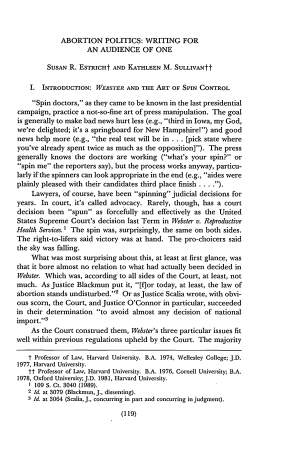Abortion Politics: Writing for an Audience of One
January 1, 1989

DISCLAIMER: This text has been transcribed automatically and may contain substantial inaccuracies due to the limitations of automatic transcription technology. This transcript is intended only to make the content of this document more easily discoverable and searchable. If you would like to quote the exact text of this document in any piece of work or research, please view the original using the link above and gather your quote directly from the source. The Sandra Day O'Connor Institute does not warrant, represent, or guarantee in any way that the text below is accurate.
Article Text
(Excerpt, Automatically generated)
ABORTION POLITICS: WRITING FOR AN AUDIENCE OF ONE
SUSAN R. ESTRICHt AND KATHLEEN M. SULLIVANtt
INTRODUCTION: WEBSTER AND THE ART OF SPIN CONTROL "Spin doctors," as they came to be known in the last presidential
campaign, practice a not-so-fine art of press manipulation. The goal is generally to make bad news hurt less (e.g., "third in Iowa, my God, we're delighted; it's a springboard for New Hampshire!") and good news help more (e.g., "the real test will be in... [pick state where you've already spent twice as much as the opposition]"). The press generally knows the doctors are working ("what's your spin?" or "spin me" the reporters say), but the process works anyway, particu larly if the spinners can look appropriate in the end (e.g., "aides were plainly pleased with their candidates third place finish ").
Lawyers, of course, have been "spinning" judicial decisions for years. In court, it's called advocacy. Rarely, though, has a court decision been "spun" as forcefully and effectively as the United States Supreme Court's decision last Term in Webster v. Reproductive Health Services. 1 The spin was, surprisingly, the same on both sides. The right-to-lifers said victory was at hand. The pro-choicers said the sky was falling.
What was most surprising about this, at least at first glance, was that it bore almost no relation to what had actually been decided in Webster. Which was, according to all sides of the Court, at least, not much. As Justice Blackmun put it, " [£]or today,
